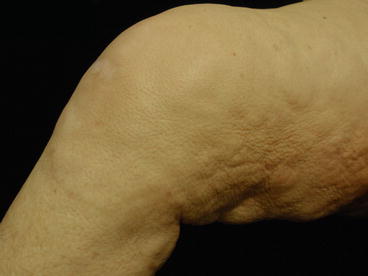Fig. 30.1
Thickened, hardened skin with brawny hyperpigmentation and raised plaques on the arm of a patient with NSF. There are fixed flexion contractures of the elbow and fingers

Fig. 30.2
“Cobblestoning” and marked induration of skin with a peau d’orange appearance on the thigh of a patient with NSF
This condition has been observed almost exclusively among patients with compromised renal function following exposure to gadolinium-containing contrast agents during imaging procedures [3, 4]. The majority of patients with NSF develop skin changes within three months of receiving a gadolinium-containing contrast agent [5].
Description
Typically, both distal lower extremities are involved initially; skin changes usually progress proximally to involve both legs and thighs and both hands, forearms, and upper arms [2]. Although occurring infrequently, skin changes may be present over the chest and abdomen and on the back. Many patients with NSF also have slightly raised, yellow plaques on the sclera of their eyes, medial and/or nasal to the iris, which often are accompanied by conjunctival injection (Fig. 30.3). However, the skin of the face is almost never affected.


Fig. 30.3
A yellow scleral plaque on the eye of a patient with NSF
As the skin around joints tightens, patients develop fixed flexion contractures that typically affect the knees, ankles, elbows, and fingers, resulting in a claw-like appearance to the hand [1, 2] (Fig. 30.4). These fixed deformities compromise physical function, often limiting the patient’s ability to walk independently and to perform fine motor functions involving the hands.


Fig. 30.4
Hardened and tethered skin around the knees of a patient with NSF causing fixed flexion contractures
Although initially recognized as a cutaneous disorder and named “nephrogenic fibrosing dermopathy” [6], extensive systemic involvement has been identified in patients with NSF, including fibrosis of lymph nodes, thyroid, esophagus, heart, lungs, liver, diaphragm, skeletal muscle, genitourinary tract, and dura mater [7, 8].
Differential Diagnosis
The vast majority of cases of NSF have occurred in patients with stage 5 chronic kidney disease (GFR <15 mL/min/1.73 m2 or requiring dialysis). Thus, other conditions should be considered in the differential diagnosis, especially when a patient has lesser degrees of renal dysfunction [2]. The appearance of NSF skin changes on the lower extremities is very similar to that of lipodermatosclerosis occurring in the setting of chronic venous stasis. However, the indurated and dyspigmented lesions of lipodermatosclerosis typically are confined to the leg below the knee and are not accompanied by joint contractures.
Although the histological appearance of NSF may be indistinguishable from that of scleromyxedema, the numerous firm, minute papules of scleromyxedema occur on the face and neck, as well as on the hands, arms, and upper trunk. Patients with NSF lack the facial involvement and paraproteinemia typically associated with scleromyxedema. Unlike scleroderma, NSF does not involve the face and is not associated with Raynaud’s phenomenon or circulating autoantibodies. The clinical appearance of NSF is similar to that of chronic graft-versus-host disease, but chronic graft-versus-host disease occurs in the setting of prior bone marrow transplantation and often involves the trunk.
Scleredema diabeticorum occurs in individuals with diabetes mellitus and presents with cutaneous induration on the shoulders and upper back. Morphea presents with a localized, linear area of cutaneous sclerosis and lacks the symmetrical distribution of scleroderma or NSF. Beta-2 microglobulin amyloidosis, which occurs exclusively in patients with stage 5 chronic kidney disease, and Dupuytren’s contracture both manifest with subcutaneous thickening on the palms of the hands that results in fixed flexion contractures of the fingers which resemble the claw-like appearance of the hand in NSF; however, neither of these conditions is associated with the cutaneous changes that cause the finger joint contractures in NSF.
Stay updated, free articles. Join our Telegram channel

Full access? Get Clinical Tree








